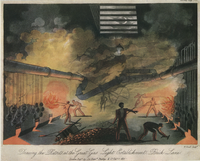
Photo from wikipedia
When coal mines exploit deep seams with high-gas content, risks are encountered due to the additional high likelihood of rock bursting potential problems. The bursts of coal pillars usually lead… Click to show full abstract
When coal mines exploit deep seams with high-gas content, risks are encountered due to the additional high likelihood of rock bursting potential problems. The bursts of coal pillars usually lead to severe fatalities, injuries, and destruction of property, including impeding access to active mine workings underground. The danger exists given that conditions in the already highly brittle coal material can be exacerbated by high stress and high gas pressure conditions. It is thus critical to develop methods that improve current understanding about bursting liability, and techniques to forecast or prevent coal bursting in underground coal mines. This study uses field data from a deep coal mine, and numerical modeling to investigate the effects of gas pressure and mechanical compressive stresses on coal bursting liability in high gas content coal seams. The bursting energy index is adopted to determine the coal bursting liability under high gas pressure conditions. The adopted methodology uses a two-staged approach comprising investigating the influence of gas pressure on the bursting liability of coal pillar, and the influence of the gas pressure on the resulting pillar failure mode. Based on numerical simulations of coal pillars, correlations are observed between the magnitudes of gas pressures and the bursting energy index. Irrespective of pillar size, failure time is shortest when the gas pressure achieves a threshold value between 50 kPa to 70 kPa. At 50 kPa, the value of the BEI increases by 50% going from the 4 m pillar to the 6 m pillar. The value of the BEI increases by 43% going from the 6 m high pillar to the 8 m high pillar at 50 kPa. When pillars fail there is a degree of stress relief leading to a reduction in bursting liability. The results suggest that before 50 kPa, pillar failure is largely due to mechanical loading. After 50 kPa, pillar failure is largely due to excessive gas pressures.
Journal Title: Energies
Year Published: 2018
Link to full text (if available)
Share on Social Media: Sign Up to like & get
recommendations!